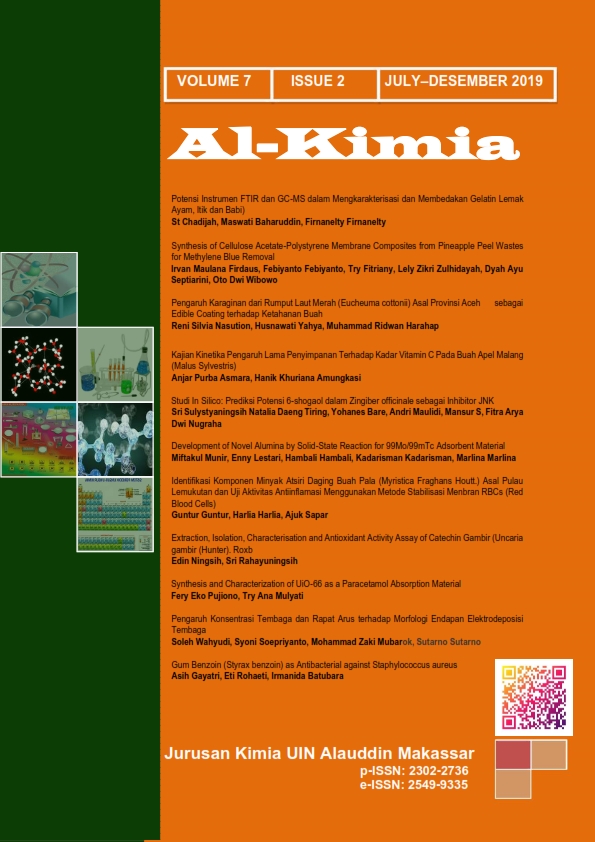Pengaruh Konsentrasi Tembaga dan Rapat Arus terhadap Morfologi Endapan Elektrodeposisi Tembaga
Abstract
Copper deposits have been obtained by the electrolysis method using copper sulfate and sulfuric acid. The effect of copper concentration and current density on the surface morphology of copper deposits and current efficiency have been studied. The variation of copper concentration is 0.04 M and 0.8 M and the variation of current density is 2-8 A/dm2. The copper deposits will be photographed macro, weighed and characterized by Scanning Electron Microscope (SEM) to determine the surface morphology of deposits and Energy-Dispersive X-ray spectroscopy (EDX) to determine the chemical composition of deposits. The surface morphology of copper deposits in the form of compact and without nodules was reached at copper concentration is 0.8 M and the current density is 2 A/dm2 with the average of current efficiency is 96%.Downloads
References
Sato, A. & Barauskas, R. (1995). Copper plating. Metal Finishing, 93 (1), Supplement 1 : 223-234.
Dini, J. W. & Snyder, D. D. (2010). Chapter 2: Electrodeposition of Copper. Modern Electroplating, edisi 5, John Wiley & Sons, Inc., Canada : 33-78.
Watkowski, J. (2008). Chapter 29: Electroplating. Printed Circuits Handbook, edisi 6, Mc. Graw Hill Handbook : 29.1-29.31.
Paunovic, M., Schlesinger, M. & Snyder, D. D. (2010). Chapter 1: Fundamental Concideration. Modern Electroplating, edisi 5, John Wiley & Sons, Inc., Canada : 1-32.
Popov, K. I. & Pavlovic, M. G. (1993). Modern Aspects of Electrochemistry, Plenum Press, New York : 299-391.
Mubarok, M. Z., Aji, L. N. & Wahyudi, S. (2017). Sintesis Serbuk Tembaga Dengan Metode Elektrolisis: Studi Perilaku Elektrokimia Dan Karakterisasi Serbuk. Prosiding SENAMM X 2017 : 623-632.
Grujicic, D. & Pesic, B. (2002). Electrodeposition of copper: the nucleation mechanisms. Electrochimica Acta, 47 (18) : 2901-2912.
Nekouei, R. K., Rashchi, F. & Amadeh, A. A. (2013). Using design of experiments in synthesis of ultra-fine copper particles by electrolysis. Powder Technology, 237 : 165–171.
Copyright (c) 2019 Soleh Wahyudi, Syoni Soepriyanto, Mohammad Zaki Mubarok, Sutarno Sutarno

This work is licensed under a Creative Commons Attribution-NonCommercial-ShareAlike 4.0 International License.
Authors who publish with this journal agree to the following terms:
1) Authors retain copyright and grant the journal right of first publication with the work simultaneously licensed under a Creative Commons Attribution License that allows others to share the work with an acknowledgement of the work's authorship and initial publication in this journal.
2) Authors are able to enter into separate, additional contractual arrangements for the non-exclusive distribution of the journal's published version of the work (e.g., post it to an institutional repository or publish it in a book), with an acknowledgement of its initial publication in this journal.
3)Authors are permitted and encouraged to post their work online (e.g., in institutional repositories or on their website) prior to and during the submission process, as it can lead to productive exchanges, as well as earlier and greater citation of published work (See The Effect of Open Access).


